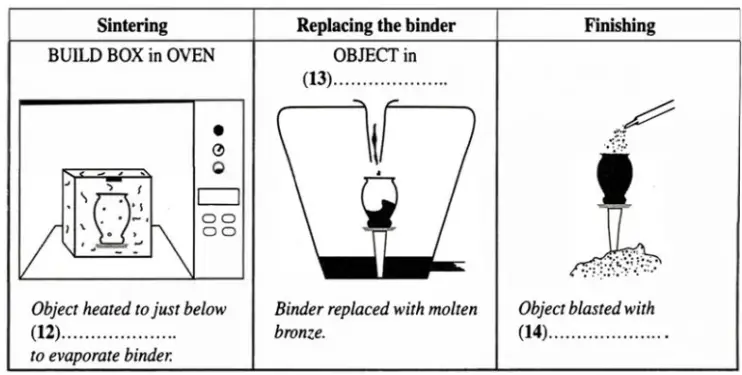You should spend about 20 minutes on Questions 1-14, which are based on the Reading Passage below.
Stainless Steel Reading Answers
Uses
A In any ordinary kitchen, there are numerous items made from stainless steel, including cutlery, utensils, and appliances. ‘Inox’ or ‘18/10’ may be stamped on the base of a good stainless steel pot: ‘Inox’ is short for the French inoxydable; while 18 refers to the percentage of chromium in the stainless steel, and 10 to its nickel content.
B In hospitals, laboratories and factories, stainless steel is used for many instruments and pieces of equipment because it can easily be sterilised, and it remains relatively bacteria-free, thus improving hygiene. Since it is mostly rust-free, stainless steel also does not need painting, so proves cost-effective.
C As a decorative element, stainless steel has been incorporated into skyscrapers, like the Chrysler Building in New York, and the Jin Mao Building in Shanghai, the latter considered one of the most stunning contemporary structures in China. Bridges, monuments, and sculptures are often stainless steel; and, cars, trains, and aircraft contain stainless steel parts.
Recent alloys
D As most pure metals serve little practical purpose, they are often combined or alloyed. Some examples of ancient alloys are bronze (copper + tin) and brass (copper + zinc). Carbon steel (iron + carbon), first made in small quantities in China in the sixth century AD, was produced industrially only in mid-nineteenth-century Europe. Stainless steel, which retains the strength of carbon steel with some added benefits, consists of iron, carbon, chromium, and nickel, and may contain trace elements. Stainless steel is a new invention – Austenitic stainless steel was patented by German engineers in 1912, the same year that Americans created ferritic stainless steel, while Martensitic stainless steel was patented as late as 1919.
Properties
E The name, stainless steel, is misleading since, where there is very little oxygen or a great amount of salt, the alloy will, indeed, stain. In addition, stainless steel parts should not be joined together with stainless steel nuts or bolts as friction damages the elements; another alloy, like bronze, or pure aluminium or titanium must be used.
F In general, stainless steel does not deteriorate as ordinary carbon steel does, which rusts in air and water. Rust is a layer of iron oxide that forms when oxygen reacts with the iron in carbon steel. Because iron oxide molecules are larger than those of iron alone, they wear down the steel, causing it to flake and eventually snap. Stainless steel, however, contains between 13-26% chromium, and, with exposure to oxygen, forms chromium oxide, which has molecules the same size as the iron ones beneath, meaning they bond strongly to form an invisible film that prevents oxygen or water from penetrating.
As a result, the surface of stainless steel neither rusts nor corrodes. Furthermore, if scratched, the protective chromium-oxide layer of stainless steel repairs itself in a process known as passivation, which also occurs with aluminium, titanium, and zinc.
Varieties
G There are over 150 grades of stainless steel with various properties, each distinguished by its crystalline structure. Austenitic stainless steel, comprising 70% of global production, is barely magnetic, but ferritic and Martensitic stainless steel function as magnets because they contain more nickel or manganese. Ferritic stainless steel – soft and slightly corrosive – is cheap to produce, and has many applications, while Martensitic stainless steel, with more carbon than the other types, is incredibly strong, so it is used in fighter jet bodies but is also the costliest to produce.
Recyclability
H Stainless steel can be recycled completely, and these days, the average stainless steel object comprises around 60% of recycled material.
Cutting-edge application
I In the last few years, 3D printers have become widespread, and stainless steel infused with bronze is the hardest material that a 3D printer can currently use.
J In 3D printing, an inkjet head deposits alternate layers of stainless steel powder and organic binder into a build box. After each layer of binder is spread, overhead heaters dry the object before another layer of powder is added. Upon completion of printing, the whole object, still in its build box, is sintered in an oven, which means the object is heated to just below the melting point, so the binder evaporates. Next, the porous object is placed in a furnace so that molten bronze can replace the binder. To finish, the object is blasted with tiny beads that smooth the surface.
Appraisal
K In less than a century, stainless steel has become essential due to its relatively cheap production cost, its durability, and its renewability. Used in the new manufacturing process of 3D printing, its future looks bright.
Questions 1-4
Choose the correct letter A, B,C, or D.
Write the correct letter in boxes 1-4 on your answer sheet.
1 A stainless steel pot with “18/10” stamped on it contains
A 18% carbon and 10% iron.
B 18%ironand 10% carbon.
C 18% chromium and 10% nickel.
D 18% nickel and 10% chromium.
2 Hospitals and laboratories use stainless steel equipment because it
A is easy to clean.
B is inexpensive.
C is not disturbed by magnets.
D withstands high temperatures.
3 Stainless steel has been used in some famous buildings for its
A durability.
B beauty.
C modernity.
D reflective quality.
4 The first type of stainless steel was patented in
A China in 1912.
B Germany in 1912.
C the UK in 1919.
D the US in 1919.
Questions 5-11
Do the following statements agree with the information given in the passage?
In boxes 5-11 on your answer sheet, write:
TRUE if the statement agrees with the information.
FALSE if the statement contradicts the information.
NOT GIVEN if there is no information on this.
5 Stainless steel does not stain.
6 Carbon steel rusts as its surface molecules are smaller than those of iron oxide.
7 Passivation is unique to stainless steel.
8 Austenitic stainless steel is the most commonly produced type.
9 These days, Martensitic stainless steel is mainly produced in China.
10 Currently, the recycling of stainless steel takes place in many countries.
11 Close to two-thirds of a stainless steel object is made up of recycled metal.
Questions 12-14
Label the diagrams below.
Choose NO MORE THAN TWO WORDS from the passage for each answer.
Write your answers in boxes 12-14 on your answer sheet.

Answer Key
| Question No. | Answer | Question No. | Answer |
| 1. | C | 8. | True |
| 2. | A | 9. | Not Given |
| 3. | B | 10. | Not Given |
| 4. | B | 11. | True |
| 5. | False | 12. | melting point |
| 6. | True | 13. | furnace |
| 7. | False | 14. | tiny beads |

